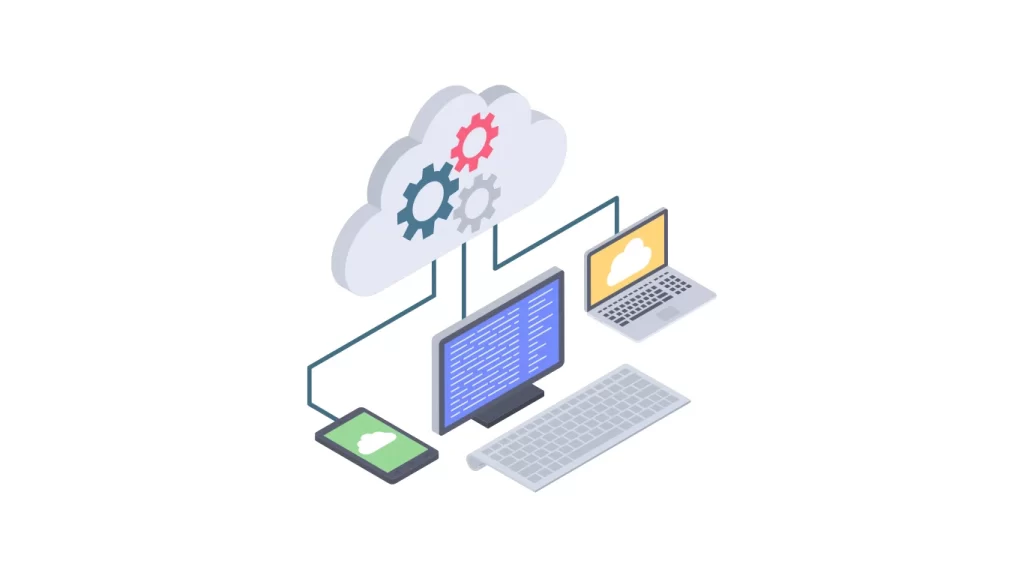Cloud computing is changing the technology industry, and businesses will spend over $1 trillion by 2024. One of the main reasons for this growth is AI-as-a-Service, which helps companies use AI models like ChatGPT more efficiently. Cloud computing helps manage IT resources, making it easier to use technologies like IoT, blockchain, and quantum computing for quick-win/fail-fast initiatives. Businesses and enterprises are shifting towards hybrid and multi-cloud strategies to make informed decisions using real-time data.
It has become increasingly important in recent years, with the market projected to reach $680 billion by 2024. This growth is being driven by AI, machine learning, and big data, making it essential for businesses to understand what cloud computing is and how it can benefit them.
This article aims to make cloud computing more accessible to readers by outlining the different types of cloud services available and the evolution of cloud computing. Using simple language and relevant examples helps readers choose the best cloud service for their business. Understanding the potential of cloud computing is crucial for advancing the future of technology.
Understanding the Cloud

During the 50’s and 60’s, mainframe computers were used for time-sharing, which allowed multiple users to access a central computer via remote terminals. This concept has evolved significantly over time, leading to the modern cloud computing model. The goal has always been to make computing power more accessible and efficient.
Today, cloud computing is defined as the delivery of various computing services over the Internet, including:
- Servers
- Storage
- Databases
- Networking
- Software
- Analytics
- Intelligence
Cloud services are available to help businesses innovate faster, access flexible resources, and save costs. With cloud services, businesses don’t need to maintain physical computing infrastructure. Instead, they can rent access from a cloud service provider. Today, cloud services cover a wide range of capabilities, from primary storage and networking to advanced features like natural language processing and (AI) artificial intelligence.
Key offerings of cloud computing, particularly from platforms like Google Cloud, include:
- AI and Machine Learning Services: Streamlining complex data analysis and predictions.
- Global Infrastructure: Ensuring reliable access and performance worldwide.
- Data Cloud Solutions: Offering comprehensive analytics tools like BigQuery and Looker.
- Database Solutions: Providing scalable options such as Cloud SQL and Firestore.
- Serverless Solutions: Enabling developers to build and run applications without managing servers.
Cloud computing is a type of technology that offers various services, from everyday apps like Gmail to enterprise solutions that manage and operate entire data systems in the cloud. The market for cloud infrastructure services is expected to grow significantly.
Cloud computing is becoming the go-to option for many applications since it reduces costs, improves scalability, and promotes collaboration. However, it also poses security challenges. Businesses must understand the different types of cloud services, which are infrastructure as a Service, Software as a Service, and Platform as a Service (PaaS). This knowledge is essential for effectively navigating the cloud computing landscape.
Types of Cloud Services

Cloud computing’s versatility is reflected in its service models, each designed to cater to different business needs. Let’s explore the primary types of cloud services:
1. Infrastructure-as-a-Service (IaaS):
- Definition: Offers virtualized computing resources over the Internet.
- Example: Amazon Web Services (AWS) provides scalable computing capacity, making it easier for businesses to run websites or applications without investing in physical hardware.
2. Platform-as-a-Service (PaaS):
- Definition: enables customers to run, create, and manage applications without the struggle of building and maintaining the infrastructure that usually comes with it. We simplify the app development and launch process so you can focus on what you do best.
- Example: Google App Engine enables developers to build scalable web applications and mobile back ends.
3. Software-as-a-Service (SaaS):
- Definition: Delivers software applications over the Internet on a subscription basis.
- Example: Salesforce.com offers customer relationship management (CRM) software as a cloud service.
Additionally, cloud computing environments can be categorized into:
- Public Cloud: Services are distributed over the public Internet and shared across organizations.
- Private Cloud: Services are maintained on a privately controlled network, offering higher security and control.
- Hybrid Cloud: It Combines both private and public cloud services, which allows data and applications to be shared across each other.
Businesses can choose from a variety of models and environments, each offering unique benefits. This helps them select the most suitable services for their specific needs, optimizing their IT infrastructure for greater efficiency and innovation.
The Evolution of Cloud Computing

Virtualization has had a significant impact on cloud computing. It has allowed for multiple virtual machines to run on a single physical server, which has made it possible to have a wider variety of infrastructure resources. The evolution of virtualization has been marked by several important milestones.
- Virtualization Technologies: Enabled the running of multiple virtual environments on a single physical hardware, optimizing resource utilization and paving the way for scalable cloud services.
The pandemic has made more people use cloud services. This has had a significant impact on how businesses and educational systems work.
- Pandemic-Driven Adoption: Worldwide spending on public cloud services witnessed a substantial increase, estimated to grow by 20.4% in 2022. This surge was partly due to the mass migration of business meetings and schooling online, benefiting SaaS vendors, especially those providing video conferencing services like Microsoft Teams and Zoom.
Looking ahead, the future of cloud computing is poised to address the growing complexity of Internet laws and regulations:
- Automated Data Governance: The development of software capable of automating data governance is anticipated. This innovation will help businesses navigate the increasing number of internet laws and regulations, ensuring compliance while leveraging cloud computing benefits.
Cloud computing is changing how businesses and individuals access and manage IT resources. It’s becoming increasingly important in our digital world.
Benefits of Moving to the Cloud

Businesses can get many benefits by moving to the cloud, such as improved efficiency and innovation. Some of the main advantages are listed below:
Cost Efficiency and Reduction:
- Major reduction in total cost of ownership (TCO) and operational expenses.
- The pay-as-you-go model reduces upfront costs, with savings of 10%-30% on cloud spend.
Agility, Flexibility, and Scalability:
- Increased agility and flexibility help businesses innovate faster and meet changing demands.
- Instant allocation of resources as demand fluctuates ensures peak load efficiency.
- Scalable options allow for easy adjustment of resources to meet organizational needs.
Security, Compliance, and Disaster Recovery:
- Built-in security and compliance protect sensitive data and business-critical workloads.
- Robust security measures include data encryption and secure access controls.
- Cloud-based systems offer robust disaster recovery capabilities for business continuity.
Cloud computing is a strategic move that can benefit a company’s bottom line and operational agility. It allows businesses to focus on their core competencies, driving growth and innovation in the digital landscape. By using cloud services, companies can stay competitive in the market. These advantages make cloud computing an essential component for businesses today.
Choosing the Right Cloud Service
Choosing the exemplary cloud service is paramount for businesses aiming to leverage cloud computing for operational efficiency and innovation. Here are key considerations to guide your selection process:
- Hybrid and Multi-Cloud Strategies:
- Popularity: Nearly 50% of mid-to-large organizations will use hybrid infrastructure by 2028, with 93% of large companies already pursuing a multi-cloud strategy.
- Benefits: Offers flexibility cost savings, and avoids vendor lock-in.
- Key Selection Criteria:
- Timing: Align the selection of cloud providers with the identification of cloud migration candidates.
- Certifications & Standards: Seek providers who are compliant with standards like ISO 27001.
- Data Security & Governance: Ensure the provider’s policies align with your organization’s risk appetite.
- Service Dependencies & Partnerships: Verify the provider’s SLAs and their partnerships’ impact on service quality.
- Costs & SLAs: Demand transparency in reporting, compliance, and billing. Scrutinize SLAs for any misleading terms.
Technological Considerations:
- Software Compatibility: Confirm cloud solutions are compatible with existing software.
- Cloud Data Security: Look for providers offering robust security measures, including multi-factor authentication and comprehensive data encryption.
- Scalability: To make sure that the service can grow with your business, allowing for future feature additions.
Understanding these factors will help businesses navigate the complex cloud services landscape, enabling them to make informed decisions that match their strategic goals and operational needs.
Conclusion
Throughout this article, we have journeyed through the transformative landscape of cloud computing, highlighting its significance in today’s digital era and its potential to shape the future of technology.
Cloud computing is a crucial part of modern innovation. It enables businesses to use Artificial Intelligence, machine learning, and big data to their advantage. By using cloud computing, companies can improve their operational agility, reduce costs, and create scalable solutions.
It plays a significant role in driving technological advancement and operational efficiency across industries. Understanding the basics of cloud services and its evolution is important to see the benefits and strategic adoption of cloud computing.
Remembering to embrace hybrid and multi-cloud strategies will give you the flexibility and cost savings that you need while also allowing you to enjoy all the benefits that cloud computing has to offer. It’s important to note that adopting cloud computing is not just about technology but also about preparing for future advancements that will change the way we interact with the digital world. This means being open to continuous learning and adaptation in the face of new challenges and opportunities.
FAQs
1. Is cloud computing set to shape the future of technology?
Cloud computing is expected to have a major impact on the future of technology. By 2024, it is predicted that cloud technology will become more advanced, secure, and integrated with other emerging technologies.
2. How does cloud computing affect technological progress?
Cloud computing has advanced technology by allowing businesses to access services they need without investing in physical infrastructure or on-site hardware. This technology is essential for digital transformation, as it offers companies flexibility and scalability that was previously not possible.
3. What are the anticipated primary uses of cloud computing in the future?
Experts predict that by 2027, the most common way of computing will be through cloud computing. This means that technology will be better suited for delivering applications and driving business innovation. Cloud computing will become a catalyst for innovation rather than just a technology platform.
4. What does the future hold for cloud computing in 2024 and the years that follow?
Cloud computing is changing, and it’s important to keep up with new trends. In 2024, one of the significant trends is “ubiquitous computing”. This means choosing the best cloud platform for each job instead of just using one public cloud. Deloitte says this is an extension of the “multi-cloud” strategy.
This change means more possibilities and better results for cloud computing. It’s essential to know the best Platform for each job and to make sure you’re using the right one.





